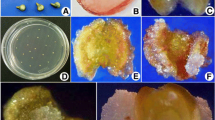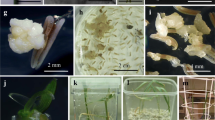Abstract
Borage (Borago officinalis L.) is an important medicinal plant with different culinary, pharmaceutical and industrial properties. Unfortunately, there are no published reports on the establishment of protocols to produce DHs in this species up to now. In this work, we show for the first time the induction of borage microspores to become embryogenic calli, from which haploid embryos are produced. In addition, we evaluated the effect of using different flower bud sizes, carbon sources, concentrations of 2,4-D and BAP, cold (4 °C) pretreatments and heat shock treatments. Production of total calli, embryogenic calli and callus-derived embryos was differently affected by the different parameters studied. Our results showed that the use of 5–7 mm-long flower buds, a cold (4 °C) pretreatment during 4 days, a 32 °C heat shock for 3 days, and the addition of 3 % maltose and 2 mgl−1 2,4-D and 1 mgl−1 BAP to the culture medium, was beneficial for embryo production. Overall, this work demonstrates that DH technology is possible in borage, and opens the door for future improvements needed to finally obtain borage DH plants.



Similar content being viewed by others
References
Abdollahi MR, Moieni A, Javaran MJ (2004) Interactive effects of shock and culture density on embryo induction in isolated microspore culture of Brassica napus L. cv. Global Iranian J Biotech 2:97–100
Bohanec B, Neskovic M, Vujicic R (1993) Anther culture and androgenetic plant regeneration in buckwheat (Fagopyrum esculentum Moench). Plant Cell Tissue Organ Cult 35:259–266
Calleberg E, Johansson L (1996) Effect of gelling agents on anther cultures. In: Jain SM, Sopory SK, Veilleux RE (eds) In vitro haploid production in higher plants, vol 23. Springer, Netherlands, pp 189–203
Custers JBM, Cordewener JHG, Nöllen Y, Dons JJ, van Lookeren-Campagne MM (1994) Temperature controls both gametophytic and sporophytic development in microspore cultures of Brassica napus. Plant Cell Rep 13:267–271
Ferrie AMR (2013) Advances in microspore culture technology: a biotechnological tool for the improvement of medicinal plants. In: Chandra S et al (eds) Biotechnology for medicinal plants. Springer, Berlin, pp 191–206
Ferrie AMR, Caswell KL (2011) Isolated microspore culture techniques and recent progress for haploid and doubled haploid plant production. Plant Cell Tissue Organ Cult 104:301–309
Ferrie AMR, Bethune T, Mykytyshyn M (2011) Microspore embryogenesis in the Apiaceae. Plant Cell Tissue Organ Cult 104:399–406
Forster BP, Heberle-Bors E, Kasha KJ, Touraev A (2007) The resurgence of haploids in higher plants. Trends Plant Sci 12:368–375
Gamborg OL, Miller RA, Ojiwa K (1968) Nutrient requirements of suspension culture of soybean root callus. Exp Cell Res 50:151–158
Guil-Guerrero JL, García-Maroto F, Vilches-Ferrón MA, López-Alonso D (2003) Gamma-linolenic acid from fourteen Boraginaceae species. Ind Crop Prod 18:85–89
Horrobin DF (1983) The regulation of prostaglandin biosynthesis by the manipulation of essential fatty acid metabolism. Rev Pure Appl Pharmacol Sci 4:339–383
Irikova T, Grozeva S, Rodeva V (2011) Anther culture in pepper (Capsicum annuum L.) in vitro. Acta Physiol Plant 33:1559–1570
Lauxen MS, Kaltchuk-Santos E, Hu CY, Callegari-Jacques SM, Bodanese-Zanettini MH (2003) Association between floral bud size and developmental stage in soybean microspores. Braz Arch Biol Technol 46:515–520
Leach CR, Mayo O, Bürger R (1990) Quantitatively determined self-incompatibility. Outcrossing in Borago officinalis. Theoret Appl Genetics 79:427–430
Lichter R (1982) Induction of haploid plants from isolated pollen of Brassica napus. Z Pflanzenphysiol 105:427–434
Maluszynski M, Kasha KJ, Szarejko I (2003) Published doubled haploid protocols in plant species. In: Maluszynski M, Kasha KJ, Forster BP, Szarejko I (eds) Doubled haploid production in crop plants. A manual. Kluwer, Dordrecht, pp 309–335
Maraschin SF, de Priester W, Spaink HP, Wang M (2005) Androgenic switch: an example of plant embryogenesis from the male gametophyte perspective. J Exp Bot 56:1711–1726
McDonald BE, Fitzpatrick K (1998) Designer Vegetable Oils. In: Mazza G (ed) Functional foods, biochemical and processing aspects. Technomic Publ Co. Inc, Lancaster, pp 265–291
Ozkum D, Tipirdamaz R (2002) The effects of cold treatment and charcoal on the in vitro androgenesis of pepper (Capsicum annuum L.). Turk J Bot 26:131–139
Parra-Vega V, González-García B, Seguí-Simarro JM (2013a) Morphological markers to correlate bud and anther development with microsporogenesis and microgametogenesis in pepper (Capsicum annuum L.). Acta Physiol Plant 35:627–633
Parra-Vega V, Renau-Morata B, Sifres A, Seguí-Simarro JM (2013b) Stress treatments and in vitro culture conditions influence microspore embryogenesis and growth of callus from anther walls of sweet pepper (Capsicum annuum L.). Plant Cell Tissue Organ Cult 112:353–360
Raquin C (1983) Utilization of different sugars as carbon sources for in vitro cultures of Petuina. Z Pflanzenphysol 111:453–457
Salas P, Rivas-Sendra A, Prohens J, Seguí-Simarro JM (2012) Influence of the stage for anther excision and heterostyly in embryogenesis induction from eggplant anther cultures. Euphytica 184:235–250
Seguí-Simarro JM (2010) Androgenesis revisited. Bot Rev 76:377–404
Seguí-Simarro JM, Nuez F (2006) Androgenesis induction from tomato anther cultures: callus characterization. Acta Hort 725:855–861
Seguí-Simarro JM, Corral-Martínez P, Parra-Vega V, González-García B (2011) Androgenesis in recalcitrant solanaceous crops. Plant Cell Rep 30:765–778
Shariatpanahi ME, Bal U, Heberle-Bors E, Touraev A (2006) Stresses applied for the reprogramming of plant microspores towards in vitro embryogenesis. Physiol Plant 127:519–534
Simon JE, Chadwick AF, Craker LE (1984) Herbs: an indexed bibliography. 1971–1980. The scientific literature on selected herbs, and aromatic and medicinal plants of the temperate zone. Archon Books, Hamden, CT
Skrzypek E, Czyczyło-Mysza I, Marcińska I, Wędzony M (2008) Prospects of androgenetic induction in Lupinus spp. Plant Cell Tissue Organ Cult 94(2):131–137
Snape JW (1989) Doubled haploid breeding: theoretical basis and practical applications. In: Mujeeb-Kazi A, Sitch LA (eds) Review of advances in plant biotechnology, 1985–1988: 2nd international symposium genetic manipulation in crops. Mexico and Manila, CIMMYT and IRRI, pp 19–30
Tipirdamaz R, Ellialtioğlu Ş (1998) The effects of cold treatments and activated charcoal on ABA contents of anthers and in vitro androgenesis in eggplant (Solanum melongena L.). In: Tsekos I, Moustakas M (eds) Progress in botanical research, Proceedings of the 1st Balkan botanical congress. Kluwer Academic Publishers, The Netherlands
Vagera J, Havranek P (1985) In vitro induction of androgenesis in Capsicum annuum L. and its genetic aspests. Biol Plant 27(1):10–21
Zur I, Dubas E, Golemiec E, Szechynska-Hebda M, Golebiowska G, Wedzony M (2009) Stress-related variation in antioxidative enzymes activity and cell metabolism efficiency associated with embryogenesis induction in isolated microspore culture of triticale (×Triticosecale Wittm.). Plant Cell Rep 28:1279–1287
Author information
Authors and Affiliations
Corresponding author
Rights and permissions
About this article
Cite this article
Eshaghi, Z.C., Abdollahi, M.R., Moosavi, S.S. et al. Induction of androgenesis and production of haploid embryos in anther cultures of borage (Borago officinalis L.). Plant Cell Tiss Organ Cult 122, 321–329 (2015). https://doi.org/10.1007/s11240-015-0768-5
Received:
Accepted:
Published:
Issue Date:
DOI: https://doi.org/10.1007/s11240-015-0768-5




